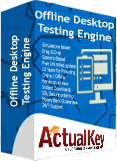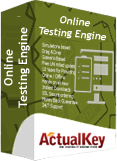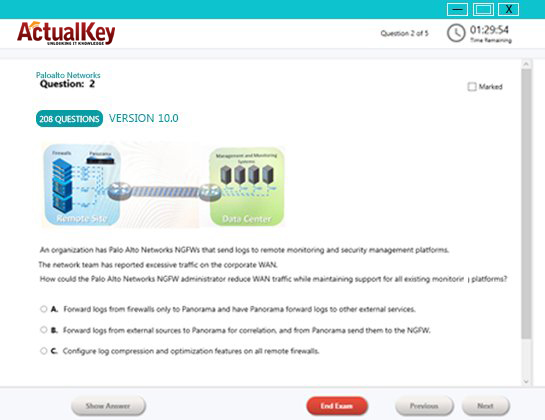Limited Time 30% Discount Offer Use Code - off30
Actualkey Prepration Latest MS-721 : Collaboration Communications Systems Engineer Exam Questions and Answers PDF's, Verified Answers via Experts - Pass Your Exam For Sure and instant Downloads - "Money Back Guarantee".
| Vendor | Microsoft |
| Certification | Microsoft 365 |
| Exam Code | MS-721 |
| Title | Collaboration Communications Systems Engineer Exam |
| No Of Questions | 240 |
| Last Updated | November 4,2024 |
| Product Type | Q & A with Explanation |
| Bundel Pack Included | PDF + Offline / Andriod Testing Engine and Simulator |
Candidates for this exam are responsible for planning, deploying, configuring, maintaining, and troubleshooting Microsoft Teams Phone, meetings, and personal and shared space devices, including Teams Rooms and Microsoft Surface Hub.
Collaboration communications systems engineers have a fundamental understanding of networking, telecommunications, audio/visual and meeting room technologies, and identity and access management. They are proficient in managing and monitoring Teams Phone, meetings, and certified devices by using the Microsoft Teams admin center, PowerShell, the Microsoft Teams Rooms Pro Management portal, and the Microsoft Call Quality Dashboard. They deploy and configure Teams Phone with PSTN connectivity through Teams Calling Plans, Operator Connect, Teams Phone Mobile, and Direct Routing.
Collaboration communications systems engineers work with Teams administrators, Microsoft identity and access administrators, and Microsoft 365 administrators. In addition, they may work with owners of other workloads, including facilities managers, network engineers, security engineers, device manufacturers, telephony providers, and Microsoft Certified solution providers.
Schedule exam
Exam MS-721: Collaboration Communications Systems Engineer
Languages: English
Retirement date: none
This exam measures your ability to accomplish the following technical tasks: plan and design collaboration communications systems; configure and manage Teams meetings and events; configure and manage Teams Phone; and configure and manage Teams Rooms and devices.
Skills measured
Review the study guide linked in the preceding “Tip” box for more details about the skills measured on this exam.
Plan and design collaboration communications systems (30–35%)
Configure and manage Teams meetings and events (10–15%)
Configure and manage Teams Phone (35–40%)
Configure and manage Teams Rooms and devices (15–20%)
About the exam
Languages
Some exams are localized into other languages. You can find these in the Schedule Exam section of the Exam Details webpage. If the exam isn’t available in your preferred language, you can request an additional 30 minutes to complete the exam.
Note
The bullets that follow each of the skills measured are intended to illustrate how we are assessing that skill. Related topics may be covered in the exam.
Note
Most questions cover features that are general availability (GA). The exam may contain questions on Preview features if those features are commonly used.
Skills measured
Audience profile
Candidates for this exam are responsible for planning, deploying, configuring, maintaining, and troubleshooting Microsoft Teams Phone, meetings, and personal and shared space devices, including Teams Rooms and Microsoft Surface Hub.
Collaboration communications systems engineers have a fundamental understanding of networking, telecommunications, audio/visual and meeting room technologies, and identity and access management. They are proficient in managing and monitoring Teams Phone, meetings, and certified devices by using the Microsoft Teams admin center, PowerShell, the Microsoft Teams Rooms Pro Management portal, and the Microsoft Call Quality Dashboard. They deploy and configure Teams Phone with PSTN connectivity through Teams Calling Plans, Operator Connect, Teams Phone Mobile, and Direct Routing.
Collaboration communications systems engineers work with Teams administrators, Microsoft identity and access administrators, and Microsoft 365 administrators. In addition, they may work with owners of other workloads, including facilities managers, network engineers, security engineers, device manufacturers, telephony providers, and Microsoft Certified solution providers.
Plan and design collaboration communications systems (30–35%)
Configure and manage Teams meetings and events (10–15%)
Configure and manage Teams Phone (35–40%)
Configure and manage Teams Rooms and devices (15–20%)
Plan and design collaboration communications systems (30–35%)
Plan and design Teams meetings
Plan and design Teams meeting policies and settings
Plan for PSTN audio conferencing
Plan for Teams live events
Compare capabilities and features of Teams Core and Teams Premium
Recommend meeting types based on business requirements (virtual appointments, webinars, live events, and Teams meetings)
Design Teams policy packages (includes meeting policies, calling policies, and live events policies)
Recommend methods for assigning policies
Plan and design Teams Phone and PSTN connectivity
Identify licensing requirements to enable Teams Phone for users, shared devices, and Teams resource accounts
Identify PSTN connectivity requirements
Plan for Teams Phone Mobile
Plan for Operator Connect
Plan for Communication Credits
Plan usage scenarios for service and user phone numbers
Choose between porting and acquiring phone numbers
Plan a solution to acquire or port phone numbers
Recommend Teams Phone devices
Plan for and recommend analog devices, SIP handsets, and SIP devices
Recommend when to use Survivable Branch Appliances (SBAs)
Plan and design Direct Routing call flows
Recommend a Session Border Controller (SBC) solution based on PSTN connectivity
Identify an appropriate compliance recording solution
Identify an appropriate certified contact center solution
Plan for SBC and SBA updates
Plan and design Teams-certified device solutions
Recommend a room configuration based on the meeting space
Recommend a room configuration based on customer and business requirements
Compare capabilities and features of Teams Rooms Basic and Teams Rooms Pro
Recommend a Teams Rooms device platform (Android vs. Windows vs. Surface Hub)
Recommend Teams-certified devices
Recommend Teams Rooms certified components
Recommend when to use coordinated meetings
Recommend when to use Cloud Video Interop (CVI) or Direct Guest Join
Identify the requirements for a Microsoft Exchange Online resource account
Identify the enrollment requirements for Microsoft Intune
Plan for advanced features on shared devices
Prepare the network for the deployment of Teams
Perform a network analysis by using the Microsoft Teams Network Assessment Tool
Determine network readiness for Teams
Determine eCDN requirements for Teams live events
Specify the network configuration for certified devices
Determine network requirements by using the Network planner for Teams
Specify the optimal network architecture for Teams
Specify Teams Quality of Service (QoS) requirements and policies
Validate local internet breakout strategy for client media optimization
Validate VPN split tunneling
Validate DNS resolves to the nearest point of entry in Microsoft 365
Configure Teams for QoS
Configure Media Bit Rate (MBR)
Create and assign a network roaming policy
Configure the network topology
Configure tenant data upload for the Microsoft Call Quality Dashboard
Configure Microsoft Power BI reports for the Microsoft Call Quality Dashboard
Configure reporting labels for Call Analytics
Troubleshoot call failures and session quality
Troubleshoot a missing dial pad
Troubleshoot calling issues by using self-help diagnostics in the Microsoft 365 admin center
Troubleshoot Azure AD sign-in issues for Teams phones
Interpret Teams media flows
Troubleshoot tenant dial plans by using regular expressions and PowerShell
Interpret E.164 normalization rules to resolve dialing issues
Interpret reverse number lookup to resolve caller ID issues
Diagnose call failures
Troubleshoot dynamic emergency address by using client debug logs
Troubleshoot Teams client media issues by using the Microsoft Remote Connectivity Analyzer for Teams
Troubleshoot calls by using Advanced Call Analytics
Troubleshoot calls by using the Microsoft Call Quality Dashboard
Inspect PSTN usage reports for SIP call failures
Configure and manage Teams meetings and events (10–15%)
Configure and manage Teams meetings
Create and manage meeting policies
Configure meeting settings
Configure and manage Teams webinars
Configure and manage Teams Premium meeting features
Create and manage Teams meeting templates
Configure and manage audio conferencing
Configure audio conferencing for Teams
Configure a default audio conferencing bridge
Configure an audio conference bridge number
Configure a toll-free conference bridge number
Assign a specific audio conferencing number to a user
Configure toll-free audio conferencing
Configure the audio conferencing numbers included in meeting invitations
Configure and manage live events
Configure the Live events settings
Create and manage live events policies
Configure meeting and event roles
Configure live events with Teams, Yammer, and Microsoft Stream
Configure and manage Teams Phone (35–40%)
Configure Teams Phone policies
Create a dial plan
Configure calling policies
Configure call park policies
Configure caller ID policies
Configure call hold policies for users
Configure outbound call restrictions
Configure inbound call blocking
Configure routing of unassigned numbers
Assign voice policies through policy packages
Configure compliance recording policies
Configure auto attendants and call queues
Design call flows for auto attendants and call queues
Configure auto attendants and call queues
Deploy channel-based call queues
Configure resource accounts
Assign licenses to resource accounts
Assign phone number to resource accounts
Assign a resource account to an auto attendant or call queue
Configure Microsoft 365 groups for voicemail
Interpret call queue conference mode
Interpret call queue routing methods
Configure holidays for auto attendants and call queues
Configure custom Music on Hold (MoH)
Assign a dynamic caller ID policy for call queues
Configure dynamic emergency calling
Design dynamic emergency calling scenarios
Configure emergency calling locations
Configure emergency calling policies
Configure networks and locations (Location Information Service (LIS))
Validate emergency address and emergency calling from Teams clients
Enable external location lookup mode
Configure and manage users for Teams Phone
Assign a Teams Phone Standard license
Assign a Teams Calling Plan
Assign user dial plans
Assign phone numbers to users by using the Microsoft Teams admin center
Assign phone number to users by using PowerShell
Assign a verified emergency address location
Assign a calling policy to a user
Assign a voice routing policy to a Direct Routing user
Configure and manage calling features for Teams Phone
Configure voicemail for users
Configure group call pickup for users
Configure Call Forwarding
Configure Simultaneous Ring
Configure call delegation for users
Enable and configure audio conferencing for a user
Assign a Dial-out from meetings policy for a user
Assign a call hold policy for a user
Configure and manage Direct Routing for Teams Phone
Configure connectivity for Teams Phone to a SBC
Create and configure an online PSTN gateway
Create PSTN usage records
Create and configure a voice route
Create and configure voice routing policies
Validate Direct Routing SBC connectivity
Troubleshoot firewall issues for Direct Routing
Troubleshoot certificate issues for Direct Routing
Troubleshoot Direct Routing SBC connectivity
Troubleshoot SIP option issues for Direct Routing
Investigate and diagnose calling issues by using an SBC SIP trace
Design and configure Location-Based Routing (LBR)
Design and configure Local Media Optimization (LMO)
Configure trunk translation rules
Configure on-network conferencing for Direct Routing
Configure an SBA
Configure and manage Teams Rooms and devices (15–20%)
Maintain Teams Rooms and devices
Configure device settings
Configure IP phone policies
Configure local network settings
Configure security and updates
Configure meeting room settings by using the Microsoft Teams admin center or the local Teams application settings
Create and configure device configuration profiles
Manage Teams Rooms from the Microsoft Teams Rooms Pro Management portal
Configure Intune policies for Teams devices
Enable advanced voice capabilities for shared space devices
Deploy common area phones
Create and manage Teams device tags
Deploy Android devices remotely
Configure SIP Gateway
Monitor Teams device health
Troubleshoot authentication issues
Troubleshoot update issues
Troubleshoot remote provisioning issues
Troubleshoot Bluetooth beaconing
Configure and manage Teams Rooms on a Surface Hub or Windows
Configure the authentication type during a Surface Hub out-of-box -experience (OOBE) setup
Configure meeting room settings on a Surface Hub device
Create and validate a Surface Hub provisioning package
Assign a provisioning package to a Surface Hub
Specify domain group policy exclusions for Teams Rooms on Windows
Configure custom displays for Teams Rooms on Windows
Customize meeting room settings by using XML files on Windows
Configure settings for peripherals for Teams Room on Windows
Configure optional features for Teams Rooms and devices
Configure HDMI ingest and options
Configure a content camera
Configure Teams casting
Auto accept a proximity join
Allow room remote
Configure an intelligent speaker
Configure Direct Guest Join
Configure hot desking on Teams shared devices
QUESTION 1
DRAG DROP
You are replacing the on-site PBX at the Georgia warehouse with Teams.
You need to maintain the functionality of the PBX after migrating to Teams.
Which sequence of steps should you perform? To answer, drag the appropriate steps to the correct
locations. Each step may be used once, more than once, or not at all. You may need to drag the split
bar between panes or scroll to view content.
NOTE: Each correct selection is worth one point.
Answer:
Explanation:
QUESTION 2
You need to recommend a solution for the new United Kingdom retail site. The solution must meet
the technical requirements. Which three actions should you include in the recommendation? Each
correct answer presents part of the solution. NOTE Each correct selection is worth one point.
A. From the Microsoft Teams admin center, assign a voice routing policy to the users.
B. From the Microsoft 365 admin center, modify the office phone numbers of the users.
C. From the Microsoft Teams admin center, modify the dial-out settings of the users.
D. From the Microsoft Teams admin center, assign the phone numbers to the users.
E. From the Microsoft Teams admin center, order five user numbers.
F. From the Microsoft 36S admin center, create a support ticket to request five phone numbers.
G. From the Microsoft Teams admin center, assign a calling policy to the users.
Answer: ACE
Explanation:
QUESTION 3
You are configuring the new call queue to replace the response group.
Which setting should you disable to ensure that the agents can receive calls from the call queue?
A. Music on hold
B. Attendant routing
C. Conference mode
D. Round robin
Answer: C
QUESTION 4
HOTSPOT
You need to assign a phone number to User1 to meet the technical requirements.
How should you complete the command? To answer, select the appropriate options in the answer area.
NOTE: Each correct selection is worth one point.
Answer:
Explanation:
QUESTION 5
HOTSPOT
You need to ensure that numbers dialed from the Melbourne warehouse conform to the dialing rules
of the phone earner. How should you complete the command? To answer, select the appropriate
options in the answer area. NOTE: Each correct selection is worth one point.
Answer:
Explanation:
Box 1: Grant-CsDialOutPolicy
Box 2: '^\+613(\d(9})$'
I Got My Success Due To Actualkey MS-721 Bundle Pack Actualkey experts I got passed in the MS-721 exam without any worries at all, these exam material products gave me the reason to relax.
Budi Saptarmat
Yahoo! Got Successfully Through The MS-721 Exam Passing Exam is not a easy thanks to Acutalkey.com for providing me actual MS-721 Collaboration Communications Systems Engineer Exam training with there included the Offline and Android simulators helps me success
Melinda
MS-721 Exam Best Preparation I have been preparing for MS-721 Collaboration Communications Systems Engineer Exam, I was not sure that I'll be able to pass because of the fact that I am not a good student however;Actualkey.com provided me best and simple exam training pdf's and I passed. I now recommend everyone
Antonio Moreno
Actualkey.com MS-721 Offline Simulator is Best My choice to select Actualkey.com and go for the preparation MS-721 Collaboration Communications Systems Engineer Exam, because I got the short way with the easy way
Liliane Meichner
Actualkey.com MS-721 Exam PDF"s passed with in a week MS-721 exam pdf's that's amazing
James Wilson
Microsoft - RELATED EXAMS
Designing a Database Server Infrastructure by Using Microsoft SQL Server 2005
Questions: 92 Questions | September 16, 2024
Optimizing and Maintaining a Database Administration Solution by Using SQL Server 2005
Questions: 215 | September 16, 2024
UPGRADE: MCDBA Skills to MCITP Database Administrator by Using Microsoft SQL Server 2005
Questions: 186 Questions | September 16, 2024
Microsoft .NET Framework 2.0 - Windows-Based Client Development
Questions: 245 Questions | September 16, 2024
Microsoft .NET Framework 2.0 - Distributed Application Development
Questions: 144 | September 16, 2024
Microsoft .NET Framework 2.0-Application Development Foundation
Questions: 456 | September 16, 2024
Designing and Developing Web-Based Applications by Using the Microsoft .NET Framework
Questions: 74 | September 16, 2024
Designing and Developing Windows-Based Applications by Using the Microsoft .NET Framework
Questions: 72 Questions | September 16, 2024
Designing and Developing Enterprise Applications by Using the Microsoft .NET Framework
Questions: 86 | September 16, 2024
UPGRADE: MCAD Skills to MCPD Web Developer by Using the Microsoft .NET Framework
Questions: 584 | September 16, 2024
UPGRADE: MCAD Skills to MCPD Windows Developer by Using the Microsoft .NET Framework
Questions: 559 | September 16, 2024
UPGRADE: MCSD Microsoft .NET Skills to MCPD Enterprise Application Developer: Part 1
Questions: 609 | September 16, 2024
UPGRADE: MCSD Microsoft .NET Skills to MCPD Enterprise Application Developer: Part 2
Questions: 168 | September 16, 2024
TS: Deploying and Maintaining Windows Vista Client and 2007 Microsoft Office System Desktops
Questions: 92 | September 16, 2024
Windows Server 2008 Applications Infrastructure, Configuring
Questions: 494 | September 16, 2024
TS: Upgrading from Windows Server 2003 MCSA to, Windows Server 2008, Technology Specializations
Questions: 576 | September 16, 2024
Designing a Microsoft Office Enterprise Project Management (EPM) Solution
Questions: 50 Questions | September 16, 2024
Customizing Portal Solutions with Microsoft SharePoint Products and Technologies
Questions: 75 | September 16, 2024
Deploying Business Desktops with Microsoft Windows Server 2003 and Microsoft Office 2003
Questions: 53 | September 16, 2024
Implementing and Administering Security in a Microsoft Windows Server 2003 Network
Questions: 288 | September 16, 2024
Designing, Deploying, and Managing a Network Solution for a Small- and Medium-Sized Business
Questions: 204 | September 16, 2024
Supporting Users and Troubleshooting a Microsoft Windows XP Operating System
Questions: 114 | September 16, 2024
TS: Microsoft SQL Server 2008, Business Intelligence Development and Maintenance
Questions: 399 | September 16, 2024
PRO: Designing, Optimizing and Maintaining a Database Administrative Solution Using Microsoft SQL Server 2008
Questions: 189 | September 16, 2024
Developing E-Business Solutions Using Microsoft BizTalk Server 2004
Questions: 40 | September 16, 2024
Developing Microsoft Office Solutions Using XML with Office Professional Edition 2003
Questions: 50 | September 16, 2024
Planning and Building a Messaging and Collaboration Environment Using Microsoft Office System and Microsoft Windows Server 2003
Questions: 61 | September 16, 2024
TS: Microsoft .NET Framework 3.5, ADO.NET Application Development
Questions: 287 | September 16, 2024
TS: Microsoft .NET Framework 3.5, ASP.NET Application Development
Questions: 364 | September 16, 2024
TS: Microsoft Office Project Server 2007, Managing Projects
Questions: 145 | September 16, 2024
TS: Microsoft .NET Framework 3.5, Windows Forms Application Development
Questions: 48 | September 16, 2024
Upgrade: Transition Your MCITP SQL Server 2005 DBA to MCITP SQL Server 2008
Questions: 98 | September 16, 2024
Pro: Designing and Deploying Messaging Solutions with Microsoft Exchange Server 2010
Questions: 379 | July 1, 2024
Pro: Designing and Developing ASP.NET Applications Using the Microsoft .NET Framework 3.5
Questions: 281 | September 16, 2024
TS: Microsoft SQL Server 2008, Implementation and Maintenance
Questions: 328 | September 16, 2024
Microsoft System Center Configuration Manager 2007,Configuring
Questions: 184 | September 16, 2024
PRO: Designing and Developing Microsoft SharePoint 2010 Applications
Questions: 200 | September 16, 2024
Upgrading to Windows 7 MCITP Enterprise Desktop Support Technician
Questions: 50 | September 16, 2024
TS: Windows Applications Development with Microsoft .NET Framework 4
Questions: 278 | September 16, 2024
TS: Windows Communication Foundation Development with Microsoft .NET Framework 4
Questions: 473 | September 16, 2024
TS: Web Applications Development with Microsoft .NET Framework 4
Questions: 405 | September 16, 2024
Pro: Designing and Developing Web Applications Using Microsoft .NET Framework 4
Questions: 288 | September 16, 2024
TS: Developing Business Process and Integration Solutions by Using Microsoft BizTalk Server 2010
Questions: 100 | September 16, 2024
Designing and Providing Microsoft Volume Licensing Solutions to Small and Medium Organizations
Questions: 232 | September 16, 2024
TS: Forefront Protection for Endpoints and Applications, Configuring
Questions: 105 | September 16, 2024
Upgrade: Transition Your MCITP SQL Server 2005 DBD to MCITP SQL Server 2008 DBD
Questions: 154 | July 1, 2024
Pro: Windows Server 2008 R2, Virtualization Administrator
Questions: 176 | September 16, 2024
PRO: Designing Database Solutions and Data Access Using Microsoft SQL Server 2008
Questions: 183 | July 1, 2024
Managing and Maintaining a Microsoft Windows Server 2003 Environment
Questions: 450 | July 1, 2024
Implementing Data Models and Reports with Microsoft SQL Server 2012
Questions: 330 | July 1, 2024
Implementing a Data Warehouse with Microsoft SQL Server 2012
Questions: 322 | September 16, 2024
Transition Your MCTS on SQL Server 2008 to MCSA: SQL Server 2012, Part 2
Questions: 300 | September 16, 2024
Configuring and Deploying a Private Cloud with System Center 2012
Questions: 462 | September 16, 2024
Monitoring and Operating a Private Cloud with System Center 2012
Questions: 457 | September 16, 2024
Administering and Deploying System Center 2012 Configuration Manager
Questions: 208 | September 16, 2024
Microsoft Dynamics AX 2012 Process Manufacturing Production and Logistics
Questions: 149 | July 1, 2024
Advanced Metro style App Development using HTML5 and JavaScript
Questions: 225 | September 16, 2024
Transition Your MCTS on SQL Server 2008 to MCSA: SQL Server 2012, Part 1
Questions: 230 | September 16, 2024
Transition Your MCITP: Database Administrator 2008 or MCITP: Database Developer 2008 to MCSE: Data Platform
Questions: 261 | September 16, 2024
Transition Your MCITP: Business Intelligence Developer 2008 to MCSE: Business Intelligence
Questions: 132 | September 16, 2024
Designing Database Solutions for Microsoft SQL Server 2012
Questions: 231 | September 16, 2024
Designing Business Intelligence Solutions with Microsoft SQL Server 2012 Exam
Questions: 314 | September 16, 2024
Microsoft Programming in HTML5 with JavaScript and CSS3 Exam
Questions: 342 | September 16, 2024
Delivering Continuous Value with Visual Studio 2012 Application Lifecycle Management
Questions: 219 | July 1, 2024
Enterprise Voice & Online Services with Microsoft Lync Server 2013
Questions: 158 | September 16, 2024
Developing Microsoft SharePoint Server 2013 Core Solutions
Questions: 181 | September 16, 2024
Upgrade your MCPD: Web Developer 4 to MCSD: Web Applications
Questions: 229 | September 16, 2024
Essentials of Developing Windows Metro style Apps using C#
Questions: 168 | September 16, 2024
Server Virtualization with Windows Server Hyper-V and System Center
Questions: 149 | September 16, 2024
Essentials of Developing Windows Metro style Apps using HTML5 and JavaScript
Questions: 166 | September 16, 2024
TS: Windows Small Business Server 2011 Standard, Configuring
Questions: 55 | September 16, 2024
TS: MS Internet Security & Acceleration Server 2006, Configuring
Questions: 80 | September 16, 2024
TS: Microsoft System Center Operations Manager 2007, Configuring
Questions: 94 | September 16, 2024
TS: System Center Virtual Machine Manager 2008, Configuring
Questions: 45 | September 16, 2024
PRO: Designing a Business Intelligence Infrastructure Using Microsoft SQL Server 2008
Questions: 115 | September 16, 2024
Upgrade: Transition Your MCITP SQL Server 2005 BI Developer to MCITP SQL Server 2008 BI Developer
Questions: 203 | September 16, 2024
Recertification for MCSD: Application Lifecycle Management
Questions: 292 | September 16, 2024
TS: Microsoft .NET Framework 3.5 Windows Presentation Foundation Application Development
Questions: 101 | September 16, 2024
TS: Microsoft .NET Framework 3.5 - Windows Communication Foundation
Questions: 270 | September 16, 2024
TS: Visual Studio Team Foundation Server 2010, Administration
Questions: 72 | September 16, 2024
Pro: Designing and Developing Windows Applications Using Microsoft .NET Framework 4
Questions: 239 | September 16, 2024
TS: Microsoft Windows SharePoint Services 3.0 Application Development
Questions: 109 | September 16, 2024
Upgrade: Transition your MCPD Enterprise Application Developer Skills to MCPD Enterprise Application Developer 3.5, Part 1
Questions: 153 | September 16, 2024
UPGRADE: Transition your MCPD Enterprise Application Developer Skills to MCPD Enterprise Application Developer 3.5, Part 2
Questions: 123 | September 16, 2024
TS: System Center Data Protection Manager 2007, Configuring
Questions: 74 | September 16, 2024
Designing and Providing Microsoft Volume Licensing Solutions to Large Organizations
Questions: 126 | September 16, 2024
TS: Designing, Assessing, and Optimizing Software Asset Management (SAM)
Questions: 85 | September 16, 2024
MS Office Communication Server 2007-U.C Voice Specialization
Questions: 174 | September 16, 2024
Microsoft Office Communications Server 2007 R2 U.C. Voice Specialization
Questions: 101 | September 16, 2024
Windows Server 2008 Hosted Environments, Configuring and Managing
Questions: 75 | September 16, 2024
Designing and Providing Microsoft Volume Licensing Solutions to Large Organisations
Questions: 104 | September 16, 2024
Pro: Designing and Developing Windows Applications Using the Microsoft .NET Framework 3.5
Questions: 105 | July 1, 2024
Pro: Designing and Developing Enterprise Applications Using the Microsoft .NET Framework 3.5
Questions: 152 | September 16, 2024
Universal Windows Platform – App Data, Services, and Coding Patterns (beta)
Questions: 47 | September 16, 2024
Universal Windows Platform – App Architecture and UX/UI (beta)
Questions: 76 | September 16, 2024
Microsoft Dynamics AX 2012 R3 CU8 Installation and Configuration
Questions: 48 | July 1, 2024
Designing and Deploying Microsoft Exchange Server 2016 Exam
Questions: 166 | September 16, 2024
Introduction to Programming Using Block-Based Languages (Touch Develop)
Questions: 72 | July 1, 2024
Development, Extensions and Deployment for Microsoft Dynamics 365 for Finance and Operations
Questions: 90 | July 1, 2024
Financial Management in Microsoft Dynamics 365 for Finance and Operations
Questions: 73 | July 1, 2024
Designing and Providing Microsoft Licensing Solutions to Large Organizations
Questions: 195 | July 1, 2024
Distribution and Trade in Microsoft Dynamics 365 for Finance and Operations
Questions: 93 | July 1, 2024
Administering Microsoft System Center Configuration Manager and Cloud Services Integration
Questions: 150 | July 1, 2024
Microsoft Configuring and Operating a Hybrid Cloud with Microsoft Azure Stack Exam
Questions: 99 | July 1, 2024
Microsoft Azure Solutions Architect Certification Transition Exam
Questions: 393 | July 1, 2024
Outlook 2016: Core Communication, Collaboration and Email Skills
Questions: 35 | July 1, 2024
Microsoft Developing Solutions for Microsoft Azure Exam
Questions: 170 / 6 Case Study | July 1, 2024
Designing and Implementing a Data Science Solution on Azure Exam
Questions: 506 | July 28, 2025
Microsoft 365 Teamwork Administrator Certification Transition Exam
Questions: 120 | July 1, 2024
Microsoft Messaging Administrator Certification Transition Exam
Questions: 155 | July 1, 2024
Microsoft Excel 2016: Core Data Analysis, Manipulation, and Presentation Exam
Questions: 35 | November 8, 2024
Microsoft Word 2016: Core Document Creation, Collaboration and Communication Exam
Questions: 35 | November 8, 2024
Microsoft Dynamics 365 for Finance and Operations, Supply Chain Management Exam
Questions: 394 | November 25, 2024
Microsoft Dynamics 365 for Finance and Operations, Manufacturing Exam
Questions: 207 | November 8, 2024
Building Applications and Solutions with Microsoft 365 Core Services Exam
Questions: 242 | July 1, 2024
Microsoft Dynamics 365: Finance and Operations Apps Solution Architect Exam
Questions: 316 | September 18, 2025
Planning and Administering Microsoft Azure for SAP Workloads Exam
Questions: 289 | August 22, 2025
Microsoft Dynamics 365: Finance and Operations Apps Developer Exam
Questions: 304 | September 22, 2025
Administering Relational Databases on Microsoft Azure (beta) Exam
Questions: 341 | December 13, 2024
Microsoft Dynamics 365 Business Central Functional Consultant (beta) Exam
Questions: 213 | September 18, 2025
Microsoft Power Platform Functional Consultant (beta) Exam
Questions: 293 | September 26, 2025
Configuring and Operating a Hybrid Cloud with Microsoft Azure Stack Hub Exam
Questions: 176 | July 1, 2024
Microsoft Dynamics 365 Fundamentals Customer Engagement Apps (CRM) (beta) Exam
Questions: 159 | October 12, 2024
Microsoft Dynamics 365 Fundamentals Finance and Operations Apps (ERP) Exam
Questions: 151 | May 27, 2025
Configuring and Operating Windows Virtual Desktop on Microsoft Azure Exam
Questions: 261 | July 30, 2025
Designing and Implementing a Microsoft Azure AI Solution (beta) Exam
Questions: 379 | August 7, 2025
Designing and Implementing Microsoft Azure Networking Solutions Exam
Questions: 294 | March 1, 2025
Designing Microsoft Azure Infrastructure Solutions (beta) Exam
Questions: 340 | October 10, 2025
Designing and Implementing Cloud-Native Applications Using Microsoft Azure Cosmos DB (beta) Exam
Questions: 144 | May 24, 2025
Configuring Windows Server Hybrid Advanced Services (beta) Exam
Questions: 255 | November 5, 2025
Administering Windows Server Hybrid Core Infrastructure (beta) Exam
Questions: 256 | September 30, 2025
Microsoft Designing and Implementing Enterprise-Scale Analytics Solutions Using Microsoft Azure and Microsoft Power BI Exam
Questions: 160 | July 1, 2024
Microsoft Dynamics 365 Supply Chain Management Functional Consultant Expert Exam
Questions: 195 | July 12, 2025
Implementing Analytics Solutions Using Microsoft Fabric Exam
Questions: 140 | August 16, 2025
Implementing Data Engineering Solutions Using Microsoft Fabric Exam
Questions: 104 | June 6, 2025
Exams code, certifications, vendor or keywords
![]()
Copyright © 2009 - 2025 Actualkey. All rights reserved.





